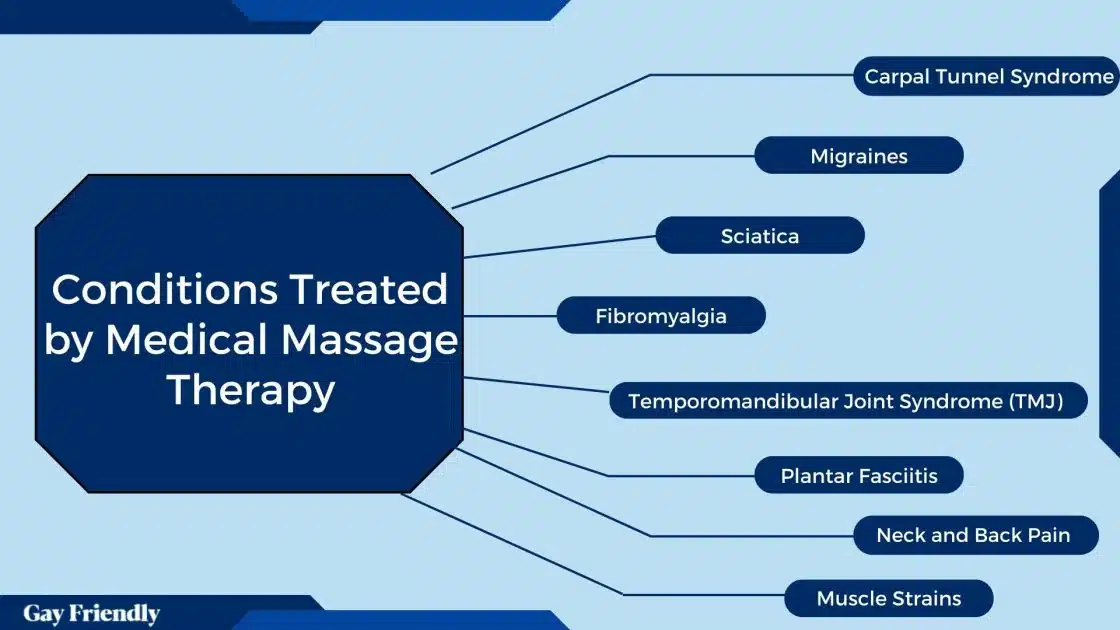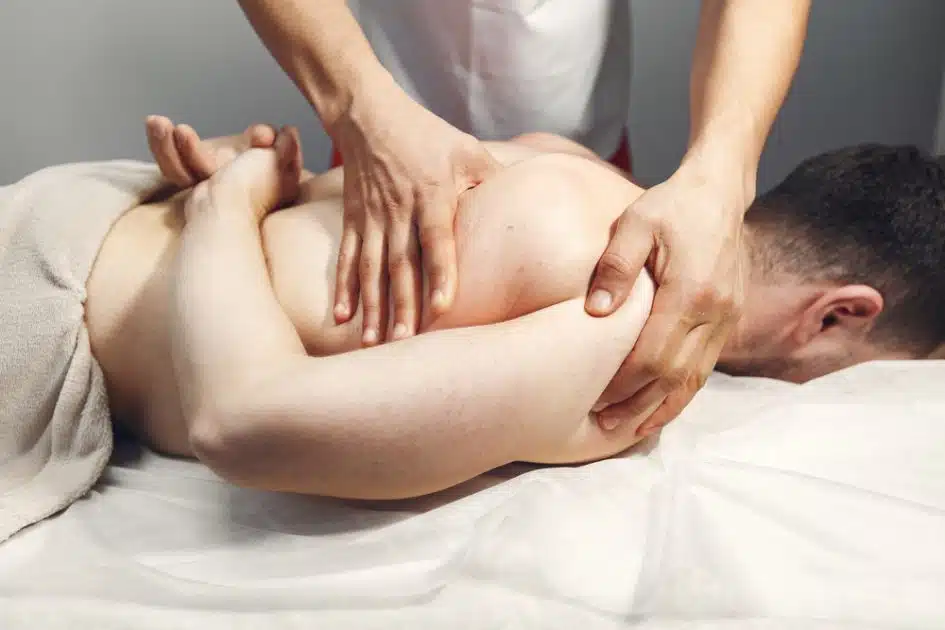Medical Massage Therapy

A Unique Intersection of Healing Touch and Modern Medicine
What is Massage 07th Aug, 2023
More individuals are turning to non-traditional, holistic medical solutions as we approach a new era of healthcare. The popularity of alternative medical techniques grows with each passing year.

This shifting tide reflects the public’s growing discontent with traditional drugs and operations, which are frequently band-aid remedies. Patients now want more tailored, less intrusive, and all-encompassing answers to their health problems.
Instead of just numbing or suppressing the symptoms with medicine or having intrusive treatments, they strive to identify and cure the underlying source of their health difficulties. The modern healthcare consumer seeks a treatment strategy that views their body as a coherent, linked system rather than a collection of separate components.
What is Medical Massage Therapy
Medical massage therapy is a unique and specialized sector within the broader landscape of massage therapy. Unlike conventional massages that primarily aim at fostering relaxation and reducing stress, medical massage therapy serves a distinctly different purpose. It’s more than just an avenue for relaxation—it’s a potent tool implemented as a vital part of a patient’s overall healthcare strategy.
This form of therapy is intricately customized to an individual’s health needs and is designed to address a particular medical diagnosis. Whether it’s chronic muscle tension, soft tissue injury, or a neurological disorder, the therapist tailors the massage techniques specifically to mitigate the medical condition at hand.

Each session of medical massage therapy is distinct and unique, much like the patients themselves. The therapists are well-trained in a broad array of techniques, enabling them to adapt their approach based on the patient’s specific condition.
They could utilize practices ranging from deep tissue massage and trigger point therapy to lymphatic drainage techniques or myofascial release, depending on the patient’s requirements.
One defining characteristic of medical massage therapy is its focused approach. These are typically the areas that are most affected by the patient’s medical condition.
Recommended:
What Massage Is Best for Neck Pain
Conditions Treated by Medical Massage Therapy
Medical massage treatment has a diverse range of disorders that it may effectively treat. This modality is not confined to a single problem but rather covers a wide range of physical and neuromuscular disorders.
Here are some of the most frequent medical massage therapy conditions:

Carpal Tunnel Syndrome
By focusing on the forearm, wrists, and hands, medical massage can help relieve discomfort and enhance hand function.
Migraines
Chronic headaches may be crippling. With its specialized approaches, medical massage treatment can help lessen the frequency and intensity of migraines.
Sciatica
Pain radiates down the route of the sciatic nerve in this syndrome. Therapists can reduce sciatic pain by using particular massage methods to relieve muscular tension in the afflicted regions.
Fibromyalgia
By increasing muscular relaxation and pain reduction, medical massage can aid in the management of fibromyalgia symptoms.
Temporomandibular Joint Syndrome (TMJ)
A condition that causes jaw discomfort and makes chewing difficult. Medical massage treatment can target the masticatory muscles to relieve stress and discomfort.
Plantar Fasciitis
This disorder might result in significant heel discomfort. Medical massage, which focuses on the lower leg and foot, can help reduce the inflammation and discomfort caused by this ailment.
Neck and Back Pain
Neck and back discomfort, whether caused by bad posture, strain, or a chronic illness such as arthritis, can be considerably relieved by specialized medical massage.
Muscle Strains
An overstretching or muscular injury might result in a strain. Medical massage therapy can aid healing by boosting blood flow, lowering inflammation, and enhancing the flexibility of injured muscles.
Medical massage therapy demonstrates the ability of alternative and holistic treatments to cure a wide range of ailments. This type of treatment emphasizes the belief that the body has an innate potential to heal itself and that it sometimes just requires a bit of competent, therapeutic touch to activate its healing mechanism.
Recommended:
Massage for TMJ Dysfunction
Techniques Employed in Medical Massage Therapy
This range of therapeutic modalities enables the therapist to develop a treatment strategy that is especially suited to the patient’s requirements.
Let’s examine some of the approaches used most commonly in medical massage therapy:
Trigger Point Therapy
It is possible for sections of the body far from the tense muscles to experience pain, discomfort, or even impairment as a result of trigger points, which are locations of tension in the muscle tissue. They frequently follow muscular injury or overuse.
In trigger point treatment, the massage therapist locates these “knots” or tight regions and employs a variety of techniques to release the tension, including pressure, friction, and stretches. This treatment aids in alleviating discomfort, extending range of motion, and boosting circulation in the injured region.
Myofascial Release
A thin layer of connective tissue called fascia surrounds and supports muscles and organs. Movement can become painful and limited when the fascia is congested or irritated.
A gentle, hands-on treatment called myofascial release involves the therapist applying steady pressure to the myofascial connective tissue limitations. By stretching and relaxing the fascia, this procedure aids in the relief of discomfort and the restoration of mobility.
Neuromuscular Therapy
In neuromuscular treatment, often known as NMT, the therapist places concentrated pressure on particular “trigger points” or regions of tension in the muscles. The central nervous system can be balanced and pain can be reduced by the pressure. People with issues including chronic pain, sciatica, rotator cuff injuries, and TMJ difficulties frequently use this therapy.
Each of these approaches has special advantages and may be applied individually or in combination to treat a patient’s particular condition. These methods highlight the richness and breadth of medical massage therapy as a highly flexible and powerful therapeutic approach.
The Medical Massage Therapy Prescription Pathway
Entering the realm of medical massage therapy often starts with a crucial step: obtaining a prescription from a certified healthcare provider. It’s important to note that massage therapists, despite their expertise and specialization, do not have the legal capacity to diagnose a medical condition. This limitation necessitates collaboration with healthcare professionals who can offer a medical diagnosis and subsequently prescribe medical massage therapy as part of a comprehensive treatment plan.
The prescription process for medical massage therapy involves several key actors, including:
General Practitioners
Commonly the first point of contact for patients, general practitioners can evaluate symptoms and prescribe medical massage therapy as a part of a larger treatment protocol.
Chiropractors
As experts in musculoskeletal health, chiropractors can diagnose conditions related to the spine, muscles, and nerves, making them a suitable source for a medical massage therapy prescription.
Neurologists
Neurologists, dealing with disorders of the nervous system, can prescribe medical massage therapy for conditions like sciatica or migraines.
Orthopedists
Specialists in the musculoskeletal system, orthopedists can recommend medical massage therapy for issues like muscle strains, arthritis, or other bone and joint conditions.
Oral Surgeons
In cases of temporomandibular joint disorders (TMJ), an oral surgeon could prescribe medical massage therapy as a non-invasive treatment option.
Psychiatrists
Acknowledging the mind-body connection, psychiatrists might prescribe medical massage therapy as a supplementary treatment for anxiety and stress-related disorders.
The need for a prescription emphasizes the medical nature of this therapy and ensures that it serves as a targeted, specific treatment for diagnosed conditions. It’s a safeguard ensuring that the therapy is not just a relaxing indulgence but a strategic approach to improve a patient’s health and well-being. It showcases the seamless blend of alternative and conventional medicine, opening the doors to more holistic, integrative healthcare pathways.
Spa Massage vs. Medical Massage
When it comes to massage therapy, it’s vital to distinguish between two fundamentally different types: medical massage and spa massage. Both practices involve manipulating the body’s soft tissues, but their goals, contexts, and methodologies vary greatly.
Spa Massage
The primary objective of a spa massage is to foster relaxation and wellness. The treatments offered in a spa are meant to help you unwind, alleviate stress, and promote a sense of tranquility.

In a spa setting:
- The massage therapist typically does not have access to your comprehensive medical history, radiographic imaging, or intricate details about your injuries or health concerns.
- The scope of techniques they can utilize is often limited, as most spas don’t employ a medical doctor who can guide or oversee the procedures.
- The interaction between you and the therapist usually ends after the session, unless you schedule another appointment.
Medical Massage
Conversely, a medical massage is a targeted form of therapy that focuses on addressing specific medical conditions and promoting healing. Unlike spa massages, these treatments are typically part of a broader healthcare regimen.

In the context of a medical massage:
- The therapy is directed toward treating a diagnosed medical condition. The treatment could be uncomfortable at times, as the goal is to alleviate pain or dysfunction in the long run, not necessarily to induce immediate relaxation.
- Medical massage therapy often involves multiple sessions as part of an ongoing, systematic treatment plan.
- A healthcare provider or a medical doctor is typically involved to monitor your progress and adjust the treatment plan as needed. This professional oversight ensures that the therapy is appropriately tailored to your condition and therapeutic needs.
In sum, a medical massage extends beyond providing momentary relaxation—it’s a strategic intervention designed for long-term healing and pain relief. Whether it’s a sports massage, therapeutic massage, or neuromuscular therapy, the primary goal of medical massage therapy remains constant: facilitating holistic healing and well-being. This form of therapy underscores the union of relaxation and rehabilitation, offering therapeutic benefits that cater to both the body and the mind.
Recommended:
How does the Feldenkrais Method differ from Massage?
The Bottom Line
As we navigate the ever-evolving landscape of healthcare, it’s clear that a one-size-fits-all approach is becoming increasingly outdated. As we negotiate the ever-changing healthcare market, it is evident that a one-size-fits-all strategy is becoming increasingly obsolete. Standing tall amidst these alternative therapies is medical massage therapy, a specialized treatment that combines the restorative powers of massage with the precision of modern medicine. Medical massage therapy moves beyond the scope of relaxation and temporary relief that traditional spa massages offer.
It delves into the realm of targeted, prescribed therapy designed to tackle specific health conditions. By focusing on particular areas of concern, and implementing techniques such as trigger point therapy, myofascial release, and neuromuscular therapy, it caters to the unique needs of each patient. It’s not only about providing temporary relief; it’s also about supporting long-term health and recovery.
Massage is used as a method for healing and rehabilitation in this therapy, which is overseen by medical specialists.
FAQs
Who needs a medical massage?
Medical massage is beneficial for those with diagnosed conditions, recovering from injuries or surgeries, or experiencing muscle tension.
What is the basic function of medical massage?
The primary function of medical massage is to alleviate pain, improve mobility, and enhance well-being by targeting specific health conditions.
What not to do after a massage?
After a massage, avoid strenuous physical activity, and consumption of alcohol or caffeine. Hydrate well and maintain a balanced diet.
When should you avoid massage?
Avoid massage during acute inflammation, infectious diseases, certain cardiovascular conditions, severe thrombosis, and immediately after surgery or radiation treatment.
What are the effects of a wrong massage?
A wrong massage can lead to injuries like sprains, bruising, inflammation, discomfort, and even muscle damage. It’s important to choose a professional and experienced therapist.
















